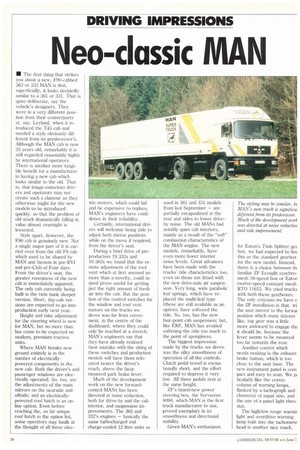Neo-classic MAN
Page 30

If you've noticed an error in this article please click here to report it so we can fix it.
• The first thing that strikes you about a new, F90-cabbed 362 or 332 MAN is that, superficially, it looks decidedly similar to a 361 or 331. That is quite deliberate, say the vehicle's designers. They were in a very different position from their counterparts at, say, Leyland, when it introduced the 1'45 cab and needed a style obviously different from its predecessor's. Although the MAN cab is now 25 years old, remarkably it is still regarded reasonably highly by international operators. There is another more tangible benefit for a manufacturer in having a new cab which looks similar to the old. That is, that image-conscious drivers and operators may not create such a clamour as they otherwise might for the new models to be introduced quickly, so that the problem of old stock dramatically falling in value almost overnight is lessened.
Style apart, however, the F90 cab is genuinely new. Not a single major part of it is carried over from the old F8 cab which used to be shared by MAN and Saviem in pre-RVI and pre-Club of Four days. From the driver's seat, the greater roominess of the new cab is immediately apparent. The only cab currently being built is the twin bunk sleeper version. Short, day-cab versions are expected to go into production early next year.
Height and rake adjustment for the steering wheel is new for MAN, but no more than has come to be expected on modern, premium tractive units.
Where MAN breaks new ground entirely is in the number of electricallypowered components in the new cab. Both the driver's and passenger windows are electrically operated. So, too, are the adjustments of the main mirrors on the nearside and offside: and an electricallypowered roof hatch is an online option. Even before reaching the, so far unique roof hatch in the option list, some operators may baulk at the thought of all these elec tric motors, which could fail and be expensive to replace. MAN's engineers have confidence in their reliability.
Certainly, international drivers will welcome being able to adjust both mirror positions while on the move if required, from the driver's seat.
During a brief drive of preproduction 19.332s and 19.362s we found that the remote adjustment of the roof vent which at first seemed no more than a novelty, could indeed prove useful for getting just the right amount of fresh air into the cab. But the position of the control switches for the window and roof vent motors on the trucks we drove was far from convenient, in the centre of the dashboard, where they could only be reached at a stretch. MAN's engineers say that they have already realised their mistake with the siting of these switches and production models will have them relocated nearer the driver's reach, above the faciamounted park brake lever.
Much of the development work on the new forwardcontrol MANs has been directed at noise reduction, both for drive-by and the cab interior, and suspension improvements. The 362 and 332's engines — basically the same turbocharged and charge-cooled 12 litre units as used in 361 and 331 models from last September — are partially encapsulated at the rear and sides to lower driveby noise. The old MANs had notably quiet cab interiors, mainly as a result of the "soft" combustion characteristics of the MAN engine. The new models, remarkably, have even more lower interior noise levels. Great advances have been made with the trucks' ride characteristics too, even on those not fitted with the new drive-axle air suspension. Very long, wide parabolic leaf springs, which have replaced the multi-leaf type (these are still available as an option), have softened the ride. So, too, has the new four-point cab suspension; but, like ERF, MAN has avoided softening the ride too much to the point of sponginess.
The biggest impression made by the trucks we drove was the silky smoothness of operation of all the controls. Clutch pedal travel is exceptionally short, and the effort required to depress it very low. All three pedals rest at the same height.
ZF's brand-new power steering box, the Servocorn 8098, which MAN is the first truck manufacturer to use, proved exemplary in its smoothness and directional stability.
Given MAN's enthusiasm for Eaton's Twin Splitter gei• box, we had expected to fint this as the standard gearbox for the new model. Instead, there is a choice between th. familiar ZF Ecosplit synchromesh 16-speed box or Eaton twelve-speed constant mesh RTO 11613. We tried trucks with both these gearboxes. The only criticism we have n the ZF installation is that, wi the seat moved to the forwai position which many drivers Like, top gear was a little more awkward to engage tha it should be, because the lever seems to be mounted too far towards the rear.
Another control which needs resiting is the exhaust brake button, which is too close to the seat base. The new instrument panel is corn. pact and easy to scan. We ix ticularly like the centre column of warning lamps, flanked by a tachograph and chometer of equal size, and the use of a panel light rheostat.
The high/low range warnin light and overdrive warning lamp built into the tachomete head is another nice touch.




























































